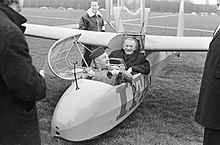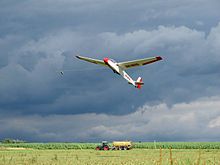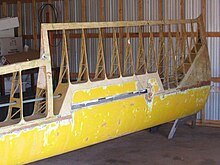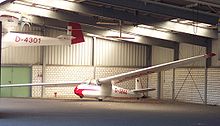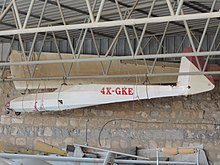Schleicher K 7
| Schleicher K 7 Rhön eagle | |
|---|---|

|
|
| Type: | Glider |
| Design country: | |
| Manufacturer: | |
| First flight: |
September 27, 1956 |
| Production time: |
1956–1966 or 1977 |
| Number of pieces: |
511 (21 of which are licensed) |
The Schleicher K 7 Rhönadler is a two-seater glider from the 1950s. The aircraft is designed as a shoulder- wing monoplane in a mixed construction. Despite its design as a robust high-performance glider, it was primarily used for training beginners. The K 7 completed its maiden flight on September 27, 1956 and was manufactured by Schleicher until 1966 . It is possible that licensed buildings were built until 1977. A total of 511 aircraft were produced, including 21 under license. After production ended, the K 7 was largely replaced as a training aircraft by its successors, the ASK 13 and ASK 21 . Today the model is enjoying increasing popularity among friends of historical glider flying, among other things because of the low purchase price and the easy repairability.
history
After the designer Rudolf Kaiser had already developed the two-seater models Ka 2 and Ka 4 Rhönlerche II at Schleicher , a more robust version of the Ka 2 was created with the K 7. The K 7 had more performance potential than the Ka 4 without having to accept any losses in robustness. The more efficient, but more damage-prone plywood hull of the Ka 2 has been replaced by a tubular steel construction . This slightly reduced the flight performance compared to the previous model, but made the aircraft more resistant to hard and foreign landings . If the covering or the tubular steel lattice hull was damaged, only the covering had to be repaired or the steel tubes replaced. Elaborate woodwork such as shafting was no longer necessary. This advantage was reflected in the commercial success of the K 7. The K 7 sold about five times more than the Ka 2.
In the early years of motor glider development, the K 7 was used as a test aircraft for simple motor glider constructions.
Most of the K 7s were approved in Germany after they were built in Poppenhausen . Some aircraft were also registered directly abroad, with most of the aircraft going to the USA and the Netherlands with 23 aircraft each approved. Associations and private individuals from Switzerland and Belgium each accepted 15 aircraft from Poppenhausen immediately after construction. 10 aircraft each were also delivered to New Zealand and Finland and a total of 9 aircraft were sold in South Africa. Some aircraft were also delivered to Great Britain and Australia.
After the K 7 had been built 490 times by Alexander Schleicher and a further 21 times under license, production was discontinued. It is certain that production at Alexander Schleicher ended in 1966. It is possible that aircraft were still produced under license until 1977.
The vast majority of the aircraft initially registered in Germany were sold abroad in the following decades. Aircraft were sold to the Czech Republic , Israel , Italy , Hungary and many other countries, for example . The exact course of certification is no longer traceable for every aircraft.
construction
The K 7 is a mixed construction glider . The fuselage consists of a tubular steel lattice construction in half-timbered construction and is covered. Sometimes it is provided with wooden moldings. The wings are made of wood , mostly covered and have a negative sweep of 6 ° at 25% wing depth. There are plywood-clad surfaces on the torsion nose , near the root rib, on the wing tip and around the airbrakes. As with the Ka 2, the spar of the wing is made of pine wood. The profile of the wings is mainly Göttingen 533, which changes to Göttingen 532 towards the wing tip.
The horizontal and vertical fin are planked, with the oars being covered with wooden structures. The elevator is trimmed using a Flettner rudder . Bumpers are used to drive the ailerons and elevators, and the rudder is connected to the pedals via control cables. The control stick on the rear seat can be removed for passenger flights by loosening a screw.
Early models had a pluggable or foldable hood with a metal frame. The hood parts were made from astralon and plexiglass . For the front seat, however, this hood offered little freedom of movement for the pilot's head. Later models were delivered with a drawn plexiglass hood, which improved visibility. To open the hinged hoods, the front hood is folded to the side and the rear hood is folded up. The drawn hood is often referred to as the "Swiss hood". In the rear seat, the passenger or the flight instructor sits with his head between the root ribs of the torsion nose of the two wings, which restricts the field of vision to the sides. In addition to the unsprung chassis, this is now seen as a disadvantage of the design. When the K 7 appeared on the market in the 1950s, the “fully glazed cabin” was still praised for its good visibility on all sides. This can be explained by the fact that the view from previously used training gliders such as the Raab Doppelraab was probably even worse. From today's perspective, the all-round view from the K 7 is poor compared to the frequently used ASK 21. The fuselage was initially planked with plywood in the front section, which was later replaced by fiberglass-reinforced plastic .
The chassis is close to the unladen center of gravity, which makes maneuvering on the ground easier. Originally the K 7 were equipped with runners and a grinding spur, which was later occasionally replaced by a nose and / or tail wheel. In front of the horizontal stabilizer, there is a tubular steel handle on each side of the fuselage. These are used to lift the fuselage when maneuvering on the ground and replace the common spur roll .
A bow and a center of gravity coupling were installed as standard. The center of gravity coupling is located off-center to the left of the fuselage, which is why the rudder must be fully turned to the left when towing in the winch start to prevent the aircraft from breaking away .
The Schempp-Hirth dive brakes extend on both the top and bottom of the wings and enable rapid descent in all speed ranges . During the testing of the aircraft, it was flown in a dive at speeds of up to 250 km / h.
Like most other gliders, the K 7 can be dismantled on a trailer for easier transport. The wings are removed individually on the left and right, the horizontal stabilizer as a whole. To remove the wings, the rudder connections, two main bolts and four connecting bolts to the fuselage must be removed. Remove the Flettner trim and a retaining screw from the horizontal stabilizer, and then remove the entire horizontal stabilizer.
Versions
The K 7 was continuously developed with minor changes during its production period. The first versions were delivered with hulls covered only with fabric, the later versions initially received a hull boat made of plywood, later made of fiberglass-reinforced plastic. In addition to the testing of two plug-in engines in the rear third of the wings, the English conversions "K 7/13" and "K 7-lookalike-ASK 13" should be emphasized. During these conversions, some enthusiasts from the Derbyshire and Lancashire Gliding Club lowered the wings of the K 7 to make the aircraft look similar to the ASK 13 without having to buy an ASK 13. The spar connections of the wings, the canopy and the fuselage cover were changed. The all-round view of the flight instructor in the rear seat improved considerably. At first glance, the K 7/13 can hardly be distinguished from an ASK 13. In the summer of 2002, six K 7/13 were still flying in Great Britain.
In-house construction, K 7s were occasionally provided with a nose wheel instead of a skid and a tail wheel instead of a grinding wheel. It was also possible to install a sprung main landing gear. These changes had to be made in accordance with Alexander Schleicher's technical notices.
The K 7 was built with two different brake flap versions. The smaller version of the airbrakes only allowed cloud flying with one seat. With the large airbrakes, cloud flying was also allowed with two seats. However, according to the flight manual, cloud flight requires additional instruments. See also minimum equipment and cloud flying .
At least one K 7 was fitted with a plug-in engine behind the main spars of the wings. The engines were provided with pusher propellers, which were located between the spars and the trailing edge. Similar to the motorization options of the K 8 , these developments disappeared with the introduction of powerful motor gliders such as the Scheibe SF 25 or the ASK 16 .
Minimum equipment and flying clouds
The flight manual from 1961 prescribes an airspeed indicator in the measuring range of 50 to 200 km / h and an altimeter as the minimum equipment for the instruments . Otherwise, only a four-part seat belt, a back cushion (if you are flying without a parachute), the trim plan, a data plate and the flight and operating manual are required as minimum equipment.
In glider pilot circles the statement is circulating that the K 7 in the version with the large airbrakes (see section Versions ) can be used for cloud flying. In principle, this statement is not wrong, but the minimum equipment of the aircraft is also increased considerably if one or two-seater cloud flights are to be carried out. This fact is often omitted in the statement. The flight manual requires a nozzle and a pitot tube with anti-icing protection for the instruments . In addition to the airspeed indicator already mentioned, a fine altimeter is required. A variometer , a compass and a turning pointer with a dummy plumb bob are also required, the drive of which must also be protected against icing. An on-board clock is also recommended as a minimum instrumentation and the installation of an artificial horizon is recommended. It is also pointed out that the regulations of the Federal Agency for Air Traffic Control must be observed.
The minimum equipment mentioned is still valid today, but today gliders are usually operated with far more instruments, which in addition to the variometer and compass usually include a radio and the FLARM collision warning system.
Naming
The official name of the aircraft according to the flight manual is Schleicher K 7 Rhönadler. However, the naming of the sneak planes often causes confusion. In the 1950s to 1960s in particular, the naming convention was changed at Schleicher and by the designer Rudolf Kaiser himself. In 1956 at the latest, Rudolf Kaiser was informed that his abbreviation “Ka” had already been used during the Second World War by the designer Albert Kalkert of the Gothaer Waggonfabrik . See for example: Kalkert Ka 430 . In 1966 at the latest, Alexander Schleicher expanded the designation to include the letters “AS” for Alexander Schleicher, which preceded the designer's abbreviation: ASK for A lexander S chleicher K aiser or ASW for A lexander S chleicher W aibel .
These circumstances ensured that the Ka 6 was registered as "Ka" in October 1955, followed by the K 7 without the "a" in September 1956. In the following years, various successors to the Ka 6, for example the Ka 6 C / CR (1959) or the Ka 6 BR-S (1963), were further provided with the Ka, while the K 6 E was largely a new development in 1965 without the a ”appeared. Various versions of the Ka 6 continued to appear with the old Ka nomenclature until 1963, when the K 7, K 8, K 9, K 10 and K 11 with the new nomenclature had already been approved in the meantime . The ASK 13 had its maiden flight in July 1966, but in April 1967 the K 12 appeared, which was later renamed ASK 14 . These circumstances make it difficult to assign the correct spelling to the individual sneak aircraft without precise knowledge of the literature.
In addition, only a few Schleicher aircraft were nicknamed. This is only the case with the designs Ka 2 Rhönschwalbe, Ka 4 Rhönlerche II, Ka 6 Rhönsegler and the K 7 Rhön eagle. Two other aircraft from Hans Jacobs and Alexander Lippisch also bear the nickname Rhönadler, like the K 7.
The epithet "Rhönadler", like other epithets of the Schleicher aircraft, is not used in common parlance by glider pilots. The aircraft are usually pronounced with "K" and the associated number. The fact that there is no difference between "K" and "Ka" in German pronunciation makes it even more difficult to use the correct, written designation. These circumstances explain why the K 7 often appears as Ka 7 in addition to its official name.
Today's meaning
Of the 511 aircraft that were once built, 131 were still registered in Germany in 2001 and 107 in 2008. Another source reported in 2002 that around 200 K 7s were still approved in Germany. Although the aircraft is number 5 among the most built double-seater gliders, its use today is mostly limited to operation by enthusiasts and only a few glider clubs. The successor models Schleicher ASK 13 and ASK 21 have almost completely displaced the K 7 with 693 and over 950 units built from the everyday flight operations of glider clubs and flight schools. The K 7 is easy to fly and can be held in slow flight with the rudder. If the spin is initiated, it can be ended again without any problems. In contrast to the ASK 21, the K 7 can spin without modifications .
A lively community of enthusiasts is developing around the Schleicher Ka and K series aircraft. Since 2006 the Segelflugverein Rhönflug Fulda eV has organized an annual “Youngtimer meeting” on the Wasserkuppe , to which the Ka 6, K 7 and K 8 models are particularly invited. Because of the great, Europe-wide interest and the associated capacity bottlenecks with regard to parking spaces for the aircraft, the number of participants had to be limited to 15 aircraft.
Many K 7s have been sold abroad from Germany over the years. The fate of the aircraft is then often uncertain. The aircraft are often damaged, after which they are no longer repaired and taken out of service.
Special events
Promotion of gliding in India
In 1959 Hanna Reitsch was sent to India with a K 7 in order to spread performance gliding there. She also undertook a 90-minute flight together with the then Indian Prime Minister Jawaharlal Nehru over New Delhi.
Accidents
Crash at Strubby Airfield
On May 26, 2004, shortly after a winch launch, a K 7 crashed during a turn near Strubby Airfield in Great Britain. The right wing broke off about a meter away from the fuselage, whereupon the aircraft fell uncontrollably to the ground. Both inmates were killed. The cause of the structural failure of the wing could not be conclusively clarified because the condition of the wood and the glue joints were obviously in order. In the same year, the British Gliding Association issued a mandatory, recurring inspection of all K 7 and K 7/13 due to the accident in order to track down any damage.
Crash when looping
On March 30, 2013, a K 7 crashed during a loop at Littlefield Municipal Airport in Texas . One of the wings of the flight figure broke, the plane went down in a spiral fall, and both occupants were killed. During the aircraft accident investigation, poor glued joints on the wing were discovered, which were caused by the ingress of moisture. An investigation according to the scheme of the British Gliding Association in the above-mentioned case could have found the weak points. In addition, the type is not approved for aerobatics. A combination of the two influencing factors - the previous damage to the wing and the aerobatic maneuver - cannot be ruled out.
Accidents in Germany since 1998
Between 1998 and 2017, the Federal Aircraft Accident Investigation Bureau recorded a total of 13 accidents involving Schleicher K 7. The aircraft were mostly slightly to severely damaged, and in two cases they were completely destroyed. In nine of the accidents no one was injured, in one case a person was lightly injured, in the other cases the occupants were seriously injured. No reliable data are available for the period prior to 1998.
Comparable aircraft types
Measured by sales figures, the K 7 is one of the most successful western gliders of the era for use as a mixed construction training aircraft. The Bergfalke III washer is comparable in terms of construction and flight performance. It was also manufactured in a composite construction and has similar flight performance. The direct competitors from the Eastern Bloc are comparable in terms of flight performance, such as the Blaník or the Bocian , but only reached the western market in small numbers. Likewise, the direct predecessors and successors of the K 7 can be viewed as comparable aircraft. The Ka 2 in particular differs only slightly from the design of the K 7. The ASK 13 is basically constructed in a similar way to the K 7, but has slightly better flight performance.
Technical specifications
| Parameter | Data |
|---|---|
| Seats | 2 |
| design type | Mixed construction |
| length | 8.15 m |
| height | 1.70 m |
| Wingspan | 16 m |
| Wing area | 17.5 m² |
| Elongation | 14.6 |
| V position | 4 ° |
| Preparation mass | 285 kg |
| Max. Takeoff mass | 480 kg |
| Front cockpit load max. | 97 kg |
| Rear cockpit load max. | 97 kg |
| Minimum speed | 59 km / h |
| Glide ratio | 25 at 85 km / h |
| Slightest sinking | 0.89 m / s at 67 km / h |
| Top speed | 170 km / h |
| Wing profile | Gö 533 mod., Outer wing: Gö 532 mod. |
See also
literature
- Peter F. Seliger: Rhön-Adler. 75 years of Alexander Schleicher glider construction. 2nd edition, Verlag RG Fischer, Frankfurt a. M. 2003, ISBN 978-3-8301-0554-1 .
- Richard and Monique Ferrière: Les Planeurs et Motoplaneurs d 'Alexander Schleicher 1951–1981. Motorbuch-Verlag, Stuttgart 1988, ISBN 3-613-01190-5 .
- Flieger Revue: magazine for aerospace, issue 1/2002, pages 67 & 68
- Dietmar Geistmann, Die Segelflugzeuge in Deutschland , 1st edition, 1979, ISBN 3-87943-618-5
Web links
- K 7 "Rhön Eagle". Alexander Schleicher, accessed on May 14, 2019 .
- Photograph of a K 7/13. Grumman G1159, accessed May 14, 2019 .
Individual evidence
- ↑ a b c d e f Bison Consultants Ltd: Schleicher K 7 production list. In: rcawsey.co.uk/. November 21, 2018, accessed May 23, 2019 .
- ↑ a b c d Peter F. Selinger: Rhön-Adler - 75 years of Alexander Schleicher glider construction 2nd corrected and supplemented edition 2003, ISBN 3-8301-0554-1 , p. 76
- ↑ a b c magazine Flieger Revue 1/2002: Collection series Schleicher K 7 Rhönadler p. 67 ff.
- ↑ a b c d K 7 "Rhön eagle". In: alexander-schleicher.de. Alexander Schleicher, accessed on May 23, 2019 .
- ↑ a b c Thomas Bergmann: K 7. (PDF; 6.6 MB) In: segelfliegen-magazin.de. Segelfliegen magazine, 2008, accessed May 23, 2019 .
- ↑ a b c d e f Flugwelt magazine , Flugwelt Verlag GmbH Wiesbaden, December 1957 issue, pp. 932, 933
- ↑ a b c d Flight and operating manual for the glider type "K 7-Rhönadler". Alexander Schleicher Segelflugzeugbau Poppenhausen / Rhön, November 16, 1961, accessed on May 8, 2019 .
- ↑ a b Peter F. Selinger: Rhön-Adler - 75 years of Alexander Schleicher Segelflugzeugbau 2nd corrected and supplemented edition 2003, ISBN 3-8301-0554-1 , p. 77
- ↑ Technical Bulletin No. 17: Installation of a star wheel instead of a grinding wheel. (PDF; 114 kB) In: alexander-schleicher.de. Alexander Schleicher Segelflugzeugbau Poppenhausen / Rhön, February 21, 1986, accessed on May 27, 2019 .
- ↑ Technical Bulletin No. 19: Installation of a nose wheel instead of a skid. (PDF; 42 kB) In: alexander-schleicher.de. Alexander Schleicher Segelflugzeugbau Poppenhausen / Rhön, March 2, 1990, accessed on May 27, 2019 .
- ↑ Amendment No. 15, Aviation Equipment, K 7, L-211: Subsequent installation of the ASK-13 wheel suspension in the K 7. (PDF; 70 kB) In: alexander-schleicher.de. Alexander Schleicher Segelflugzeugbau Poppenhausen / Rhön, February 29, 1968, accessed on May 28, 2019 .
- ^ Peter F. Selinger: Rhön-Adler - 75 years of Alexander Schleicher sailplane construction, 2nd corrected and supplemented edition 2003, ISBN 3-8301-0554-1 , p. 72
- ↑ Peter F. Selinger: Rhön-Adler - 75 years of Alexander Schleicher Segelflugzeugbau 2nd corrected and supplemented edition 2003, ISBN 3-8301-0554-1 , p. 89
- ^ Peter F. Selinger: Rhön-Adler - 75 years of Alexander Schleicher Segelflugzeugbau, 2nd corrected and supplemented edition 2003, ISBN 3-8301-0554-1 , pp. 62-107
- ↑ Gerhard Marzinzik: 10. youngtimer meeting - With Ka 6, 7 and K 8 Ka to the water dome. aerokurier.de, January 25, 2016, accessed on May 14, 2019 .
- ^ John W. Hoskins: Glider Accident Report No: 36/04. (PDF; 300 kB) British Gliding Association, October 17, 2005, accessed on May 23, 2019 (English).
- ↑ Jim Hammerton: Aircraft Inspection 042/07/2004 - Mandatory. (PDF; 150 kB) In: streckenflug.at. British Gliding Association, July 22, 2004, accessed May 23, 2019 .
- ↑ NTSB Identification: CEN13FA213. In: aviation-safety.net. National Transportation Safety Board, March 30, 2013, accessed May 23, 2019 .
- ↑ Klaus-Uwe Fuchs, Roland Karnbach: Investigation Report BFU17-0437-3X. (PDF; 850 kB) In: bfu-web.de. Federal Bureau of Aircraft Accident Investigation, April 30, 2017, accessed on May 23, 2019 .
- ↑ Accidents and serious disruptions with aircraft under 5.7 t in Germany 1998–2010. (CSV; 1.1 MB) In: bfu-web.de. Federal Bureau of Aircraft Accident Investigation, February 24, 2015, accessed on May 23, 2019 .
- ↑ Accidents and serious disruptions with aircraft under 5.7 t in Germany from 2011. (CSV; 450 kB) In: bfu-web.de. Federal Bureau of Aircraft Accident Investigation, 2019, accessed on May 21, 2019 .
